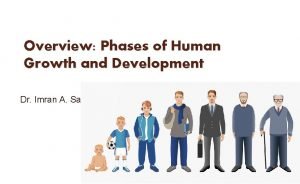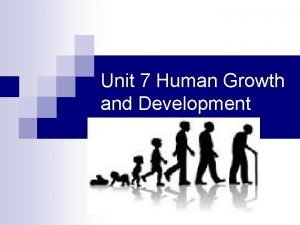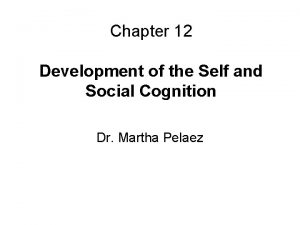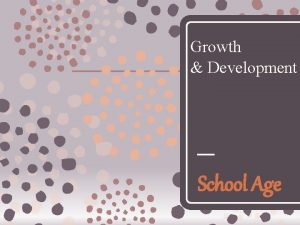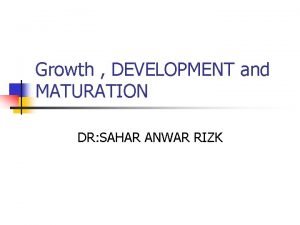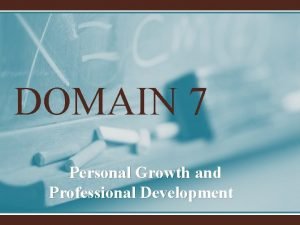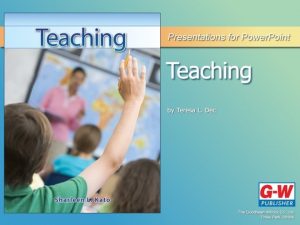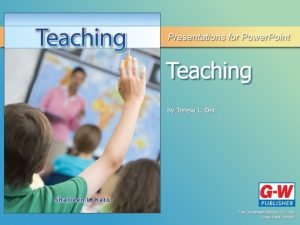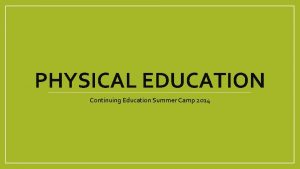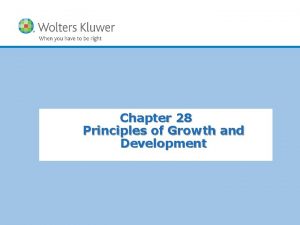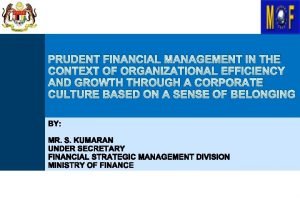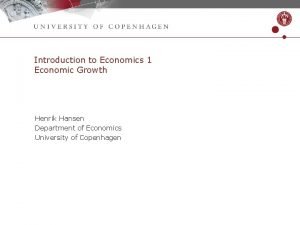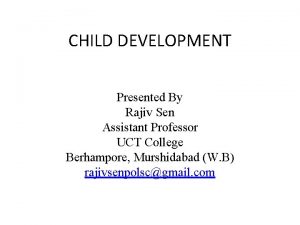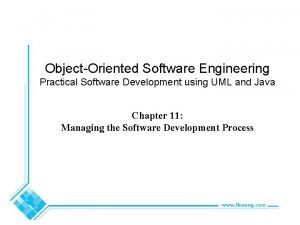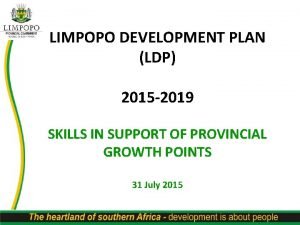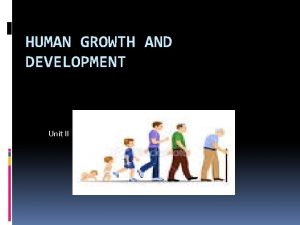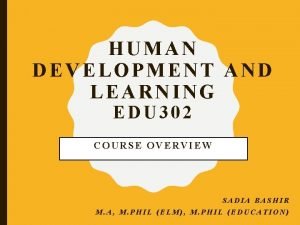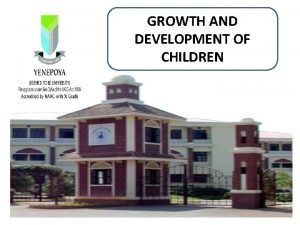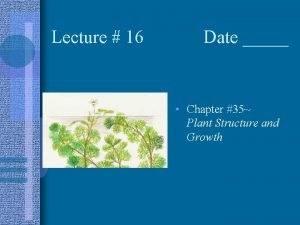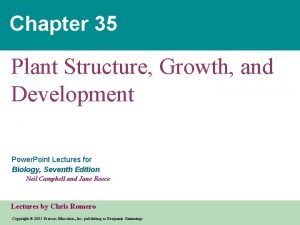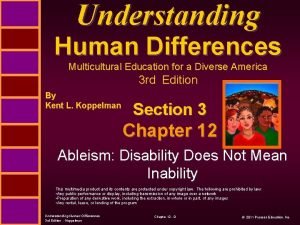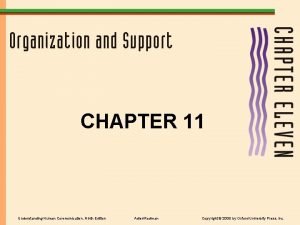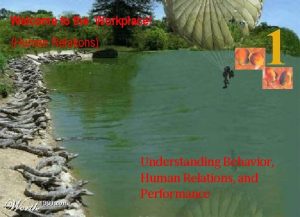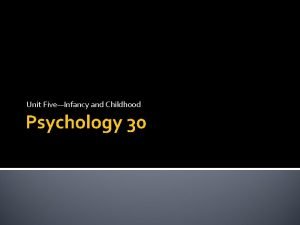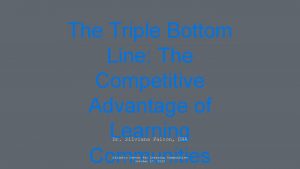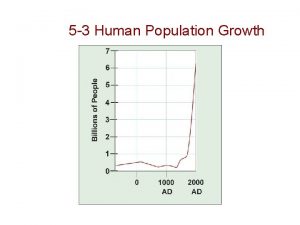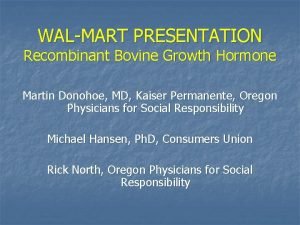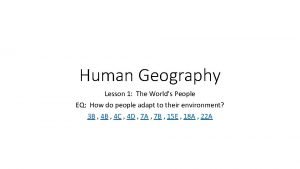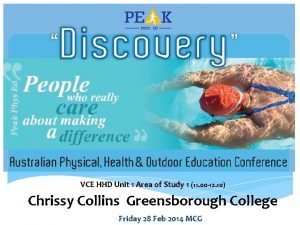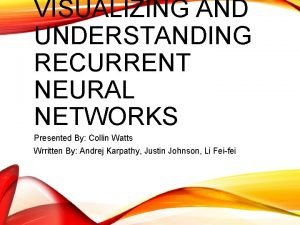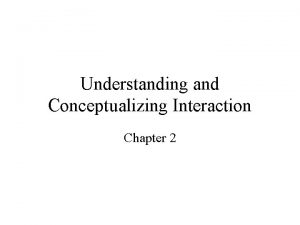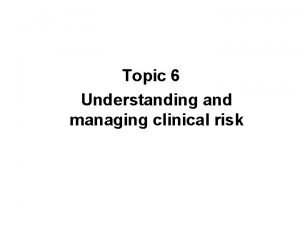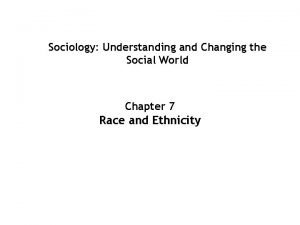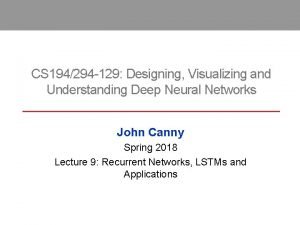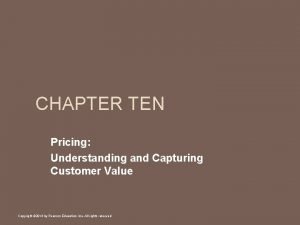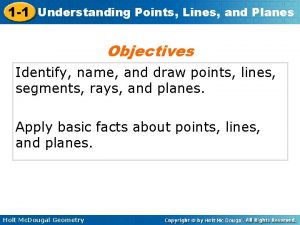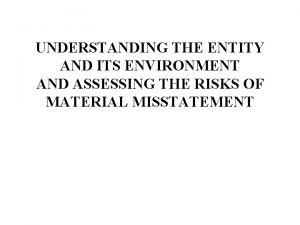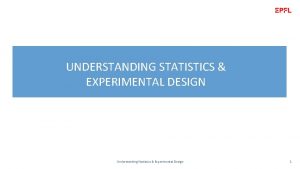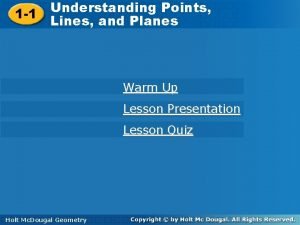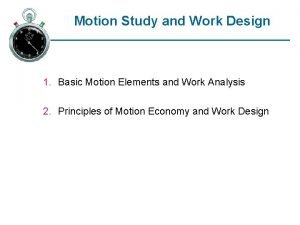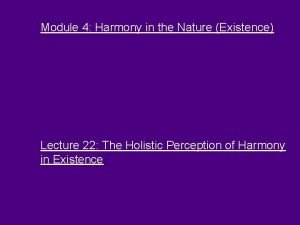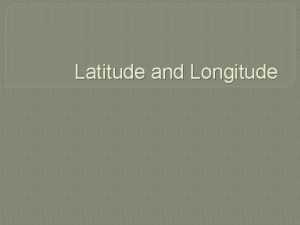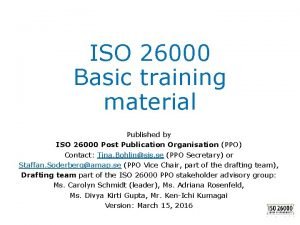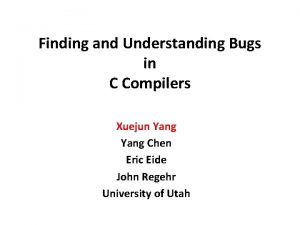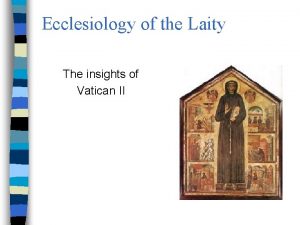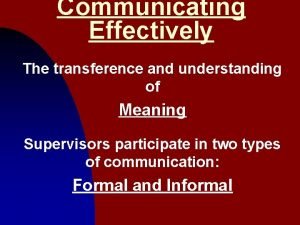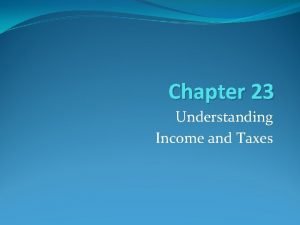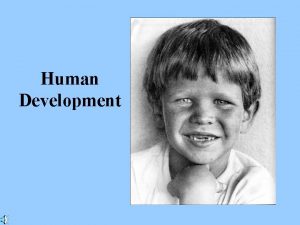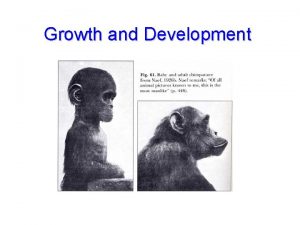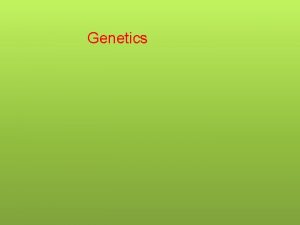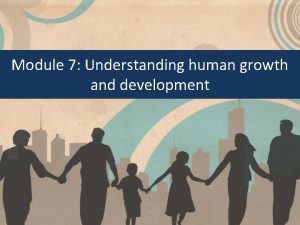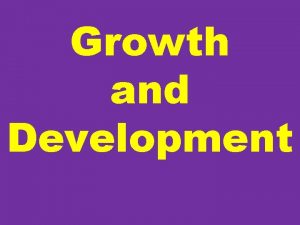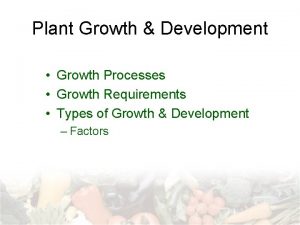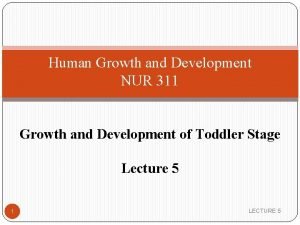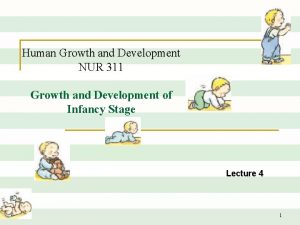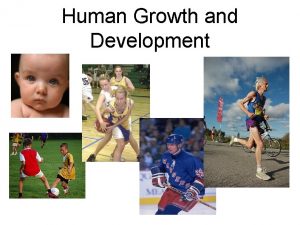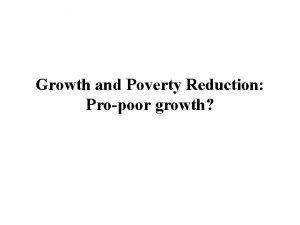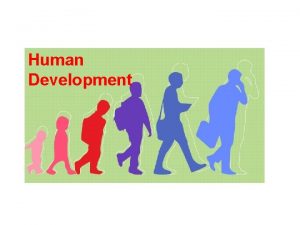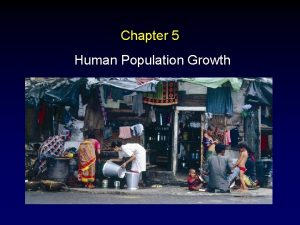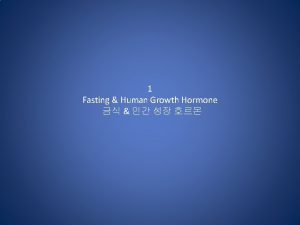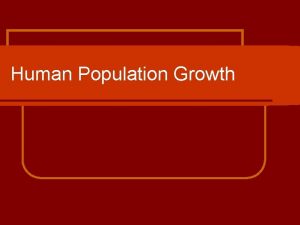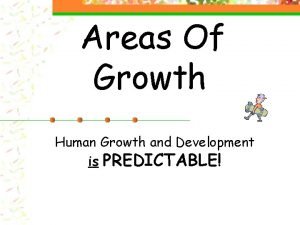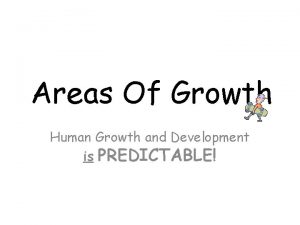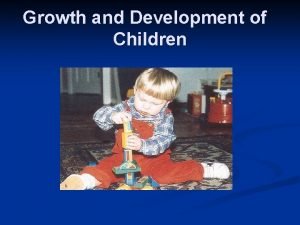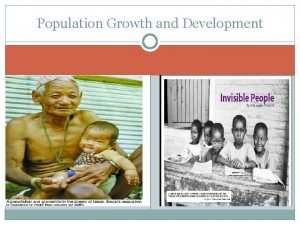HUMAN GROWTH AND DEVELOPMENT Understanding of human development




















































































- Slides: 84

HUMAN GROWTH AND DEVELOPMENT. Understanding of human development through life span.

HUMAN GROWTH AND DEVELOPMENT n GROWTH DEVELOPMENT

GROWTH

GROWTH

An overview of growth and development. GROWTH n Is physical change and increase in size. n n can be measured quantitatively. Indicators includes height, weight, bone size etc.

An overview of growth and development. GROWTH n vary during different stages of life. n n The rate is rapid during the prenatal, neonatal, infancy and adolescent stages and slows during childhood. is minimal during adulthood

DEVELOPMENT

An overview of growth and development. DEVELOPMENT is the behavioral aspect of growth. It is the enhancement of psychomotor skills. Development is interdisciplinary process and includes motor, coginitive, language and social development.

HUMAN GROWTH AND DEVELOPMENT (definition). THE SCIENTIFIC STUDY OF n THE processes of development that human beings undergo from conception to throughout life span. n The ways in which changes occur throughout life and the qualities, that remain stable.

HUMAN GROWTH AND DEVELOPMENT. The study serves different purposes: Understanding of normal patterns which helps to identify disruption in processes. Provides framework of deep understanding of the patient as an individual person.

HUMAN GROWTH AND DEVELOPMENT The study serves different purposes: Helps in gathering the data, construction of a treatment plan in a way that will be more individualized for your patient. Helps in building a multi strategy approach in dealing with youth risks behavior thus promoting the positive dev of one.

HUMAN GROWTH AND DEVELOPMENT. The study serves different purposes: Understanding of global development in physical, coginitive and social context and ability to apply the knowledge. Practical implication in different fields ranging from child rearing to education and healthcare.

HUMAN GROWTH AND DEVELOPMENT. n The study serves different purposes: n Development of social policies for children. n Helps to go through and bear influences of transitions and loss in life, in adulthood.

HUMAN GROWTH AND DEVELOPMENT. EVOLUTION: Started in late 18 century from the studies of child development. Now it is the scientific study of changes occur throughout the life span(life-span development).

HUMAN GROWTH AND DEVELOPMENT ASSUMPTIONS OF LIFE-SPAN VIEW OF DEVELOPMENT: 1. Development is a lifelong process. 2. Development is multidirectional. 3. Development involves both gain and loss. 4. There is much plasticity in human development

HUMAN GROWTH AND DEVELOPMENT ASSUMPTIONS OF LIFE-SPAN VIEW OF DEVELOPMENT: 5. Development is shaped by its historical and cultural context. 6. Development is multiply influenced. 7. Understanding development requires multiple disciplines.

HUMAN GROWTH AND DEVELOPMENT. OBJETIVES: Four objectives of the study. DESCRIPTION. EXPLANATION. PREDICTION. MODIFICATION.

HUMAN GROWTH AND DEVELOPMENT. DOMAINS OF DEVELOPMENT: 3 domains are interlinked and affect each other. n Physical development. n Coginitive development. n Psychosocial development.

HUMAN GROWTH AND DEVELOPMENT. PERIODS OF LIFE SPAN: life span is divided into different periods. These periods contribute upto certain extent normal range of all 3 developments.

HUMAN GROWTH AND DEVELOPMENT. PERIODS OF LIFE SPAN: 1. Prenatal period ( conception to birth). 2. Infancy and toddlerhood (upto 3 yrs). 3. Early childhood (3 -6 yrs). 4. Middle childhood (6 -11 yrs).

HUMAN GROWTH AND DEVELOPMENT. PERIODS OF LIFE SPAN: 5. Adolescence (11 -20 yrs). 6. Young adulthood (20 -40 yrs). 7. Middle adulthood ( 40 -65). 8. Late adulthood (65 and over).

HUMAN GROWTH AND DEVELOPMENT. Influences on Development: Heredity. Family. Environment. Socio-economic status and neighbourhood. Culture. Maturation.

HUMAN GROWTH AND DEVELOPMENT THEORY AND RESEARCH

THEORY AND RESEARCH THEORY: Theory is a set of logically related concepts or statements.

THEORY AND RESEARCH THEORY: Theory is a set of logically related concepts or statements. Theory explain some phenomenan or process.

THEORY AND RESEARCH THEORY: Theory is a source of collecting and organizing the data. .

THEORY AND RESEARCH THEORY: Theory is a source of collecting and organizing the data. It is a source providing assumptions, tentative explainations, or predictions. .

THEORY AND RESEARCH THEORY: Theory is a source of collecting and organizing the data. It is a source providing assumptions, tentative explainations, or predictions. It provides opportunity to find further facts through analyzing the previous work.

THEORY AND RESEARCH. BASIC THEORETICAL ISSUES: There are 3 basic debatable issues. Heredity or environment. Active or passive. Continuous or occur in stages.

THEORETICAL ISSUES. Heredity or environment? ? ? ? What influence more on development.

HEREDITY OR ENVIRONMENT n IMPACT OF HEREDITY Like produces like.

IMPACT OF HEREDITY Like produces like. n Each individual is a unique combination of shared characteristics

IMPACT OF HEREDITY Like produces like. n Each individual is a unique combination of shared characteristics genetic coding help in physical development and does impart some positive or negative traits to an individual

HEREDITY OR ENVIRONMENT IMPACT OF ENVIRONMENT: Reffers to both physical environment (a good example is prenatal nutrition) and social environments (such as the neighborhood, media and peer pressure. )

HEREDITY OR ENVIRONMENT Environmental factors have different levels of impact on human development

HEREDITY OR ENVIRONMENT Environmental factors have different levels of impact on human development Involving multiple layers of action, ranging from most immediate (families, friends, and neighborhoods) to bigger societal contexts (school systems and local governments

HEREDITY OR ENVIRONMENT environmental factors have different levels of impact on human development involving multiple layers of action, ranging from most immediate (families, friends, and neighborhoods) to bigger societal contexts (school systems and local governments). macro factors such as politics on the international level

SO NATURE OR NURTURE? ? n NATURE in the form of inherited traits does exist BUT!!!!!!

SO NATURE OR NURTURE? ? n NATURE in the form of inherited traits does exist BUT!!!!!! Nurture along with the environmental factors influence the person’s overall behavior

SO NATURE OR NURTURE? ? GENETIC CODING does impart some positive or negative traits to an individual. However,

SO NATURE OR NURTURE? ? GENETIC CODING does impart some positive or negative traits to an individual. However, UPBRINGIGNG can be utilized to improve positive traits and diminish the effect of negative traits in a child.

SO NATURE OR NURTURE? ? Talents have been given by NATURE BUT!!!

SO NATURE OR NURTURE? ? Talents have been given by NATURE BUT!!! talents can only be developed into skills through the hard work of NURTURE. n

SO NATURE OR NURTURE? ? TO CONCLUDE Nature has strong influence but needs to furnish. Development is the smooth blend of both.

BASIC THEORETICAL ISSUES IS DEVELOPMENT ACTIVE OR PASSIVE? ? ?

ACTIVE OR PASSIVE? ? ? n THINK OF A PERSON SMOKING, WHAT MAKES HIM TO SMOKE IS IT REFLECTIVE OR INFLUENCED BY INNER DESIRES

ACTIVE OR PASSIVE? ? ? Machinistic model: development is passive and predictable and responses of inner or outer stimulus.

ACTIVE OR PASSIVE? ? ? n THINK OF A PERSON SMOKING, WHAT MAKES HIM TO SMOKE IS IT REFLECTIVE OR INFLUENCED BY INNER DESIRES

ACTIVE OR PASSIVE? ? ? Organismic model: development is active and more initiative then just reactions. Depends upon inner desires.

ACTIVE OR PASSIVE? ? ? n THINK OF A PERSON SMOKING, WHAT MAKES HIM TO SMOKE IS IT REFLECTIVE OR INFLUENCED BY INNER DESIRES

BASIC THEORETICAL ISSUES IS DEVELOPMENT CONTINUOUS OR OCCUR IN STAGES? ? ?

CONTINUOUS OR OCCUR IN STAGES? ? ? MECHANISTIC VIEW: continuous and predicted. e. g walking, crawling. It measures quantity, that is frequency of responses. ORGANISMIC VIEW: dev occurs in stages. Dev at one step is actually a continuition of previous skill and prepares for next skill.

THEORY AND RESEARCH Theoretical perspectives: Five major perspectives: 1. Psychoanalytic. 2. Learning.

THEORY AND RESEARCH Theoretical perspectives: 3. Coginitive. 4. Psychosocial. 5. Contextual.

THEORY AND RESEARCH: n Finding out questions through scientific method. n reliable and valid information can be provided. n Theories may be retested through research. n Research evolves new theories or phenomenan.

RESEARCH IN HUMAN GROWTH AND DEVELOPMENT Human development and family relations professionals rely on research findings. n n counselors need to know about the latest advances in family or play therapy techniques. A gerontologist may examine the most effective way to help elderly adults cope with loss of memory skills.

RESEARCH IN HUMAN GROWTH AND DEVELOPMENT n n A pediatric nurse working with chronically ill children may find ways to reduce children's fear of medical procedures. An elementary school teacher may want to investigate the current debate in reading instruction before designing a curriculum based entirely on phonics.

RESEARCH IN HUMAN GROWTH AND DEVELOPMENT n n Educators must keep up with research on the effectiveness of different teaching strategies for visual, auditory, and kinesthetic learners research knowledge will help you become a more informed citizen on issues of public policy and planning.

RESEARCH IN HUMAN GROWTH AND DEVELOPMENT n Research is also important when developing and assessing the effectiveness of pilot programs designed to achieve certain goals- for example, to reduce teen pregnancy or to increase low income elderly adults' access to health care.

TYPES OF RESEARCH Research in human growth and development falls in two categories, based on the goal of research n BASIC RESEARCH. n APPLIED RESEARCH.

TYPES OF RESEARCH n BASIC RESEARCH: goals may be Understanding fundamental behavioral processes. n describe an aspect of human nature n n describe the phenomenon of interest and increase the existing knowledge base.

TYPES OF RESEARCH q APPLIED RESEARCH : goals may be adress practical problems. bring some social change provide a solution to a problem or to improve a situation.

TYPES OF RESEARCH BASIC RESEARCH can describe children's memory abilities; APPLIED RESEARCH would be interested in enhancing children's eyewitness memory.

Examples of Basic research questions n Recognition of the mother's face by six-monthold infants: A neurobehavioral study. n Effectiveness of elaborative strategy use: Knowledge access comparisons. n The role of economic and environmental factors in single mothers' discussions with their children.

Examples of Applied research questions n n n Risk factors for falls in a community based prospective study of people 70 years and older. An attributional intervention to reduce peerdirected aggression among African American boys. A picture book reading intervention in day care and home for children from low-income families.

TYPES OF RESEARCH n EVALUATION RESEARCH. Evaluation of need: conducts need assessment study Process evaluation: Evaluate operation of program Outcome evaluation: Economic efficiency assessment: Evaluate outcomes Evaluate costs and of program benefits of program

TYPES OF RESEARCH q DEVELOPMENTAL RESEARCH examines the role of age-related changes on behavior. Developmental researchers study the age variable by selecting individuals of different ages or studying the same individuals at different points in their lives. I

TYPES OF RESEARCH CULTURAL RESEARCH focuses on aspects of development and social structure among people of different cultural backgrounds. Helps to understand "universals" in developmental processes-characteristics inform us about differences between cultural groups, thus understanding of the different ways people view the world

ORIGINS OF SCIENTIFIC ENQUIRY STEPS OF RESEARCH PROJECT.

ORIGINS OF SCIENTIFIC ENQUIRY WHAT IS THE FIRST THING YOU NEED FOR A RESEARCH? ?

ORIGINS OF SCIENTIFIC ENQUIRY WHAT IS THE FIRST THING YOU NEED FOR A RESEARCH? ? n IDEA!!!!

ORIGINS OF SCIENTIFIC ENQUIRY WHAT IS THE FIRST THING YOU NEED FOR A RESEARCH? ? n IDEA!!!! COMES FROM COMMON SENSE. OBSERVATION. THEORIES. PAST RESEARCH.

ORIGINS OF SCIENTIFIC ENQUIRY 2. HYPOTHESIS. A statement about something that may be true.

ORIGINS OF SCIENTIFIC ENQUIRY 2. HYPOTHESIS. A statement about something that may be true. It is based on the idea that you want to investigate.

ORIGINS OF SCIENTIFIC ENQUIRY 2. HYPOTHESIS. A statement about something that may be true. It is based on the idea that you want to investigate. It is formulated in formal and specific pattern showing relationship between atleast two variables in a particular population

ORIGINS OF SCIENTIFIC ENQUIRY 2. HYPOTHESIS. A statement about something that may be true. It is based on the idea that you want to investigate. It is formulated in formal and specific pattern showing relationship between atleast two variables in a particular population. The study is designed to test the hypothesis.

ORIGINS OF SCIENTIFIC ENQUIRY 3. LIBRARY RESEARCH( A TRIP TO A LIBRARY). Provides you the information, already exist. Clarify the concepts. Help to design the study.

ORIGINS OF SCIENTIFIC ENQUIRY 4. DESIGN THE STUDY Choice of a tool. Decide the sample. Gathering and analyzing the data.

RESEARCH ARTICLE n ANATOMY OF RESEARCH ARTICLE. ABSTRACT. RESULT INTRODUCTION DISCUSSION METHOD SUMMARY.

RESEARCH ARTICLE n ABSTRACT. Brief summary of research Report. Purpose to introduce the reader to decide the relevancy. Contains information of all major sections: The Problem, Method used, Results and Implication of study.

RESEARCH ARTICLE INTRODUCTION: A logical format to introduce the research. n Describes the connection between past research, theories and current problem. States the specific expectation in the form of HYPOTHESIS.

RESEARCH ARTICLE n METHOD: A straightforward report of what the researcher did. A DETAILED description of Research design, participants, procedures, events, apparatus etc. Help the reader understand exactly how the study was conducted and allow other researchers to replicate the study

RESEARCH ARTICLE RESULTS: Present the findings. There are 3 ways to present the results. n Narrative form: The whole sentence. Statistical form: Visual form: Numerical values and symbols. Use of tables and graphs.

RESEARCH ARTICLE n DISCUSSION: Explains and evaluate the findings. Suggestions for broader implication of results and further research.
 Stages of human growth and development pictures
Stages of human growth and development pictures Theory of growth and development
Theory of growth and development Human growth and development
Human growth and development Emotional development is often stormy and in conflict
Emotional development is often stormy and in conflict Unit 7:1 life stages
Unit 7:1 life stages Chapter 7 human growth and development
Chapter 7 human growth and development What is growth analysis
What is growth analysis Pith
Pith Primary growth and secondary growth in plants
Primary growth and secondary growth in plants Chapter 35 plant structure growth and development
Chapter 35 plant structure growth and development Growthchain
Growthchain Geometric growth vs exponential growth
Geometric growth vs exponential growth Neoclassical growth theory vs. endogenous growth theory
Neoclassical growth theory vs. endogenous growth theory Organic growth vs inorganic growth
Organic growth vs inorganic growth 8.3 human needs
8.3 human needs Chapter 8 human needs and human development
Chapter 8 human needs and human development Development of self and social understanding
Development of self and social understanding Pretest growth development and sexuality
Pretest growth development and sexuality Maturation
Maturation Infancy stage of development
Infancy stage of development Late childhood
Late childhood Economic growth vs economic development
Economic growth vs economic development Personal development domains
Personal development domains Growth and development pictures
Growth and development pictures Middle childhood growth and development
Middle childhood growth and development Distinguish between growth and development
Distinguish between growth and development Summer camp 2014
Summer camp 2014 Rice plant morphology
Rice plant morphology Principles of growth and development
Principles of growth and development Prudent financial management practices
Prudent financial management practices Cytokinin function
Cytokinin function Economic growth and development
Economic growth and development Growth and development
Growth and development Growth and development principles
Growth and development principles Limpopo provincial growth and development strategy
Limpopo provincial growth and development strategy Four main types of growth and development
Four main types of growth and development Definition of growth and development
Definition of growth and development Principle of growth and development
Principle of growth and development Middle childhood age
Middle childhood age Chapter 35 plant structure growth and development
Chapter 35 plant structure growth and development Xylem und phloem
Xylem und phloem Understanding human differences 5th edition
Understanding human differences 5th edition Adler and rodman 2006
Adler and rodman 2006 Understanding human communication 14th edition
Understanding human communication 14th edition Understanding human relations
Understanding human relations Human development index definition ap human geography
Human development index definition ap human geography Hgh before and after
Hgh before and after Bill cosby psychology
Bill cosby psychology Human growth
Human growth Slow growth cities ap human geography
Slow growth cities ap human geography Whats a density dependent limiting factor
Whats a density dependent limiting factor Global population age distribution
Global population age distribution Where to boy human growth hormone walmart
Where to boy human growth hormone walmart Slow growth cities ap human geography definition
Slow growth cities ap human geography definition Slow growth cities definition ap human geography
Slow growth cities definition ap human geography Economic growth vs economic development
Economic growth vs economic development Diversity and human needs and development
Diversity and human needs and development Hhd study design
Hhd study design Human nouns
Human nouns Visualizing and understanding recurrent networks
Visualizing and understanding recurrent networks Visualizing and understanding convolutional networks
Visualizing and understanding convolutional networks Understanding standards art and design
Understanding standards art and design Sqa understanding standards art and design
Sqa understanding standards art and design Conceptualizing interaction
Conceptualizing interaction Managing clinical risk
Managing clinical risk Sociology understanding and changing the social world
Sociology understanding and changing the social world Lack of understanding between parents and child
Lack of understanding between parents and child Ubd essential questions
Ubd essential questions Visualizing and understanding recurrent networks
Visualizing and understanding recurrent networks Pricing understanding and capturing customer value
Pricing understanding and capturing customer value Understanding points lines and planes
Understanding points lines and planes Understanding the entity and its environment
Understanding the entity and its environment Understanding statistics and experimental design
Understanding statistics and experimental design Understanding points lines and planes
Understanding points lines and planes Thank you for you listening
Thank you for you listening Demonstrate knowledge and understanding
Demonstrate knowledge and understanding Effective therbligs
Effective therbligs Universal human order
Universal human order Understanding latitude and longitude
Understanding latitude and longitude 7 core subjects of iso 26000
7 core subjects of iso 26000 Finding and understanding bugs in c compilers
Finding and understanding bugs in c compilers Insights and understanding ecclesiology
Insights and understanding ecclesiology Understanding points lines and planes answer key
Understanding points lines and planes answer key Transference and the understanding of meaning
Transference and the understanding of meaning Chapter 23 understanding income and taxes
Chapter 23 understanding income and taxes


